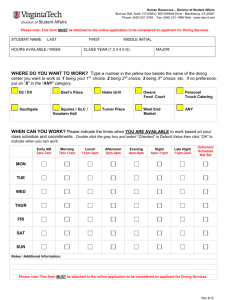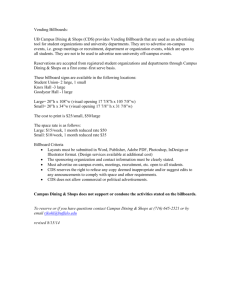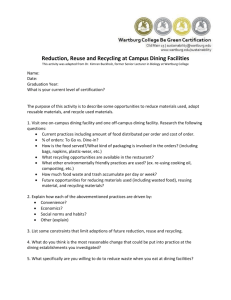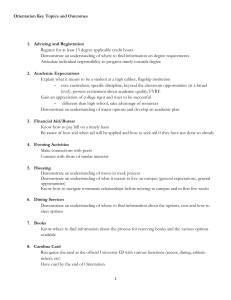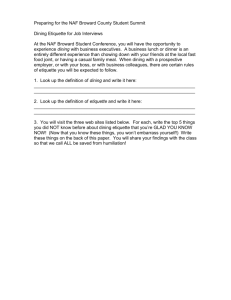Case Study on Transitioning to Self
advertisement
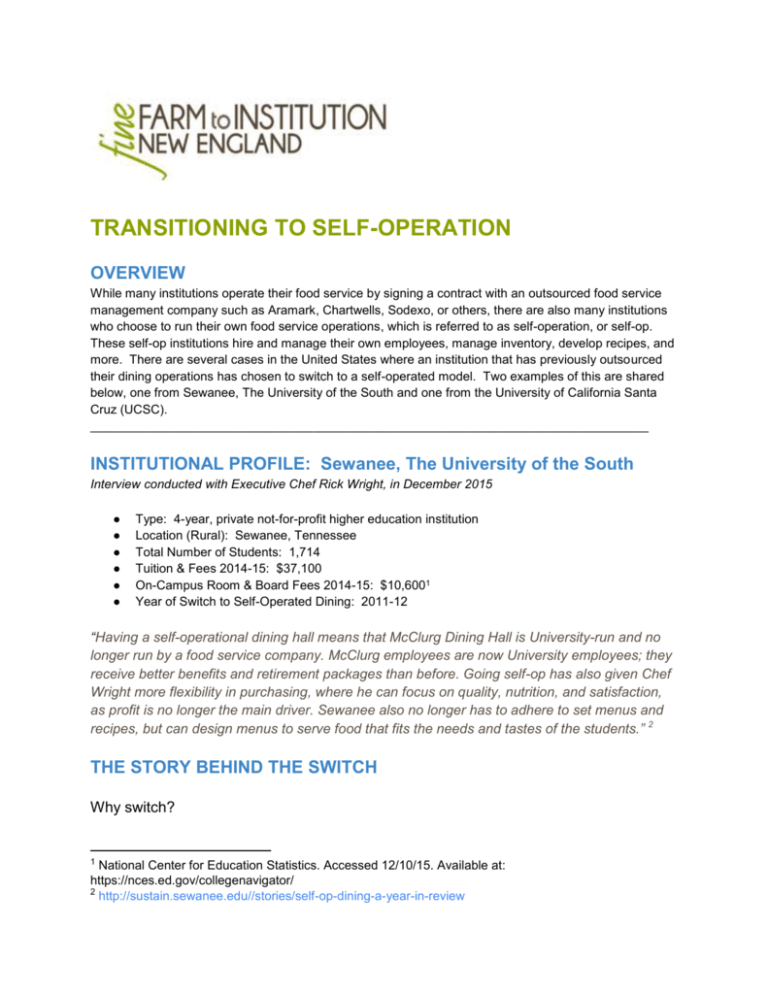
TRANSITIONING TO SELF-OPERATION OVERVIEW While many institutions operate their food service by signing a contract with an outsourced food service management company such as Aramark, Chartwells, Sodexo, or others, there are also many institutions who choose to run their own food service operations, which is referred to as self-operation, or self-op. These self-op institutions hire and manage their own employees, manage inventory, develop recipes, and more. There are several cases in the United States where an institution that has previously outsourced their dining operations has chosen to switch to a self-operated model. Two examples of this are shared below, one from Sewanee, The University of the South and one from the University of California Santa Cruz (UCSC). ________________________________________________________________________________ INSTITUTIONAL PROFILE: Sewanee, The University of the South Interview conducted with Executive Chef Rick Wright, in December 2015 ● ● ● ● ● ● Type: 4-year, private not-for-profit higher education institution Location (Rural): Sewanee, Tennessee Total Number of Students: 1,714 Tuition & Fees 2014-15: $37,100 On-Campus Room & Board Fees 2014-15: $10,6001 Year of Switch to Self-Operated Dining: 2011-12 “Having a self-operational dining hall means that McClurg Dining Hall is University-run and no longer run by a food service company. McClurg employees are now University employees; they receive better benefits and retirement packages than before. Going self-op has also given Chef Wright more flexibility in purchasing, where he can focus on quality, nutrition, and satisfaction, as profit is no longer the main driver. Sewanee also no longer has to adhere to set menus and recipes, but can design menus to serve food that fits the needs and tastes of the students.” 2 THE STORY BEHIND THE SWITCH Why switch? 1 National Center for Education Statistics. Accessed 12/10/15. Available at: https://nces.ed.gov/collegenavigator/ 2 http://sustain.sewanee.edu//stories/self-op-dining-a-year-in-review ● ● ● ● Focus on Mission - Provide a greater focus on organizational goals and mission rather than a focus primarily on profit, while still supporting fiscal responsibility. Students First - University leadership posed the question: “How can we best provide service to our students?” In thinking about that question, they recognized that the eating patterns developed by students on campus were going to follow them for the rest of their lives. Autonomy in Food Procurement - The University wanted to reduce the red tape associated with institutional food procurement and prioritizing suppliers that were based in the community. Employee wages - The University wanted to maintain more control over the human resources aspects of food service department. While their FSMC had been using the federal minimum wage for food service workers, the University had an interest in offering a livable wage. After the switch took place, all food service employees were given a 10% raise. History Prior to the transition to self-operated dining, the management at Sewanee had contracted with several different companies, with the last FSMC holding the contract for the previous twelve years. Of a $6 million account, the FSMC received $400,000 in profit annually. The University operated with a “full board program” in which the FSMC received 100% of the agreed upon total regardless of actual participation in the program. For example, if 70% of anticipated students participated in the meal program, the institution still paid the FSMC at 100%. Therefore, any percentage that wasn’t used became profit for the company. The University wanted to recoup these monies and reallocate them to labor and local, sustainable food sourcing. Who Made the Transition Possible? The transition to self-operation took several months, culminating in the expiration of the University’s contract with the FSMC in July 2011. Two key administrative positions supported this effort and helped to ensure its success. This included the V.P. of Administrative Services, Frank Gladu, who left a position at Vanderbilt Dining to help support this switch in 2010, and Vice-Chancellor John McCardell, Jr., who was the former president of Middlebury College. In addition, the Universitys’ affiliation with National Association of College and University Food Service (NACUFS) allowed them to access a network of other facilities and resources to support them in their transition. The institution is now in its fourth year since the transition to self-operated dining. What Has Changed Since the Transition? ● ● ● ● ● ● ● ● ● ● There is higher participation in the meal program than before. The institution has not had to increase their board rate. More money stays with the University. They purchase from 15 different farmers and have a new process to accept bids from vendors. They prioritize building menus that allow for local and seasonal options. They currently have a goal of 20% local and will be aiming for 30% in the next few years. They are utilizing the Real Food Challenge Calculator. They have higher retention for their kitchen staff (3-4 years), and have different insurance and benefit programs in place. They have added Human Resources staff dedicated to the food service department. The operational budget is the same, but it is now spent differently. They became a member of a group purchasing organization (GPO) to assist with managing some of their food costs. RECOMMENDATIONS & CONSIDERATIONS FOR SELF-OP "There was a lot of talk about how hard it would be, but it really wasn't that hard." - Rick Wright, Executive Chef ● Prepare staff to allocate time to the transition. During the transition and initial implementation of the new program, management will need to be present. ● Gather support from leadership and staff within the organization prior to the shift. ● Consider adding staff to the Human Resources Department to assist in developing a new set of practices and policies for food service personnel. ● In sourcing more fresh and local food, conduct trainings for production staff to develop their ability to process whole foods (ex: whole chicken, fresh produce). ● Allow time to develop relationships with new suppliers and local farmers. Local producers and new vendors may be concerned that the institution will not follow through and purchase consistently. ● Be prepared for the potential loss of employees in the transition. Only one senior management level person chose to stay throughout the transition at Sewanee. ● Take advantage of the opportunity to connect the food program with the organization’s values. Sewannee sent a daily email to staff and students with the menu for the day, including nutrition information and food system topics like food justice. RESOURCES An overview of the switch to self-op at Sewanee: http://sustain.sewanee.edu//stories/self-op-dining-a-year-in-review A walk-through tour of Sewanee’s McClurg Dining Hall: http://food-management.com/colleges-ampuniversities/walk-through-tour-sewanees-mcclurg-dining-hall#slide-0-field_images-24061 ________________________________________________________________________________ INSTITUTIONAL PROFILE: University of California Santa Cruz (UCSC) ● ● ● ● ● ● Type: 4-year, public higher education institution Location (Small City): Santa Cruz, California Total Number of Students: 17,866 Tuition & Fees 2014-15: $13,397 (in-state), $36,275 (out-of-state) On-Campus Room & Board Fees 2014-15: $14,7303 Year of Switch to Self-Operated Dining: 2004 “Dining Services, started in 2004 after the campus ended its contract with integrated food and facilities management giant Sodexo, has become one of the most cutting-edge campus food service divisions in the nation, constantly seeking out and incorporating innovative methods to increase sustainability and reduce waste.”4 3 National Center for Education Statistics. Accessed 12/10/15. Available at: https://nces.ed.gov/collegenavigator/ 4 http://news.ucsc.edu/2009/04/2852.html THE STORY BEHIND THE SWITCH Why switch? ● ● ● Balance of Mission and Fiscal Management- When the University’s food service was contracted out, it did not seem to fully align with the University’s mission and interest in putting students first. Becoming a self-op allowed the University to ensure that its values were prioritized by implementing a plan that aligned the mission of dining services and that of the University and contributed dollars back to campus. Food Service Worker Rights - In 2003, a student protest in collaboration with the AFSCME labor union highlighted social justice issues. It became clear that the pay, benefits and retirement packages of food service employees paled in comparison to what they would receive as University employees. The long-range satisfaction of employees and students benefits the entire campus. Local and Sustainable Food Procurement - Student activists elevated their interest and need for more local and Organic foods. History Student activism played a large role in the shift to self-operated dining at UCSC. In 2003, Students for Organic Solutions (a group at UCSC), brought stakeholders together to discuss the campus food system as a part of their annual Earth Summit. They were interested in identifying ways to create change in the system, including purchasing more organic produce from local farmers. At the same time, students were also expressing frustration with the contracted FSMC’s labor practices. The discussions continued at the next Earth Summit, and as a result, the participants formed a Food Systems Working Group. This group created purchasing guidelines for the campus that focused on local, organic, and worker-supported food procurement. The Systems Working Group noted that the FSMC had been on campus for nearly 40 years and many employees had worked for them for nearly 20 years. Yet these employees would have been paid higher wages and had access to more benefits and better retirement packages if they had been employees of the University itself. This discrepancy attracted the attention of the Vice Chancellor, who agreed with the student claims. In addition, he recognized that the campus population had grown, with a greater number of students were now living on campus. His goal was for the dollars from dining services and the University mission to focus on students as their highest priority. Steps were then taken to move towards self-operation starting in September 2003 and UCSC ended its contract with their FSMC in June 2004. The Food Systems Working Group has been instrumental in the success of Dining and ensuring alignment with student and campus priorities. Who Made the Transition Possible? Student groups who were organizing for change were the primary driver for this switch. This led to the development of an internal committee which played an essential role. This committee was made up primarily of housing staff, human resources, IT, payroll, and students identified the necessary steps and processes to move toward self-operation. Two consultants were hired who assisted in crafting a master plan for the transition. They forecasted profitability dependent upon implementing mandatory meal plans in the apartments on campus. They also noted that labor costs would increase, requiring a focus on increased sales and savings in food costs. The University’s affiliation with the National Association of College and University Food Service (NACUFS) assisted in engaging members and peers from other campuses for consultation and assistance with planning. New processes were developed for staff timekeeping, menu management, and accounting. Individuals from these departments did much of the legwork to implement those steps. A second dining professional was hired to help manage the operations in 2004. What Has Changed Since the Transition? ● ● ● ● Implementation of mandatory meal plans in on-campus apartments. This decision also benefitted the University by creating more reasons for first-year students to leave their apartments and socialize, which had become an issue on campus prior to the mandatory meal plan. Apartment residents have shown increased satisfaction with living on campus and with dining operations, which has increased occupancy rates for the apartments. The food service employees are now paid a higher wage. UC Santa Cruz Dining was the first University in the country to have their Chancellor sign the Real Food Challenge and set their own goal of purchasing 40% real food by 2020, doubling the industry standard. Local and Organic purchases began once the new Director for Dining was hired starting with buying coffee directly from third world co-operatives. UC Santa Cruz Dining has grown to become the 33rd largest dining operation in the country. RECOMMENDATIONS & CONSIDERATIONS FOR SELF-OP “There’s no “free ride”. Going self-op simply restructures how the institution and the students pay for the services.” ● ● ● ● ● ● Don’t be afraid of the financial implications. It is challenging to forecast the impact, but you can hire professional consultants and utilize existing resources to make your financial goals clear and attainable. Engage associations like NACUFS, as well as peer dining directors and management from other institutions, for guidance and support. Consider the following items when exploring a transition to self-operation: ○ What are your goals and priorities: social justice, local and organic, focusing on students first, etc.? ○ What operation do you have now and where do they think you’ll be in five years? ○ What are the needs of your dining services (e.g. sales volume for meal plans and retail, population served, your culture as a residential or commuter campus, and your infrastructure, etc.)? You may find that there is a need to outsource smaller operations with lower volume. ○ What fundamental changes need to be made to be profitable or break even? What items are you willing to subsidize? ○ Are you willing to raise prices, increase residential population, implement mandatory meal plans, add facilities, etc.? Labor is more expensive when self-operated. Offsetting these increases requires making operational changes through your meal plan program and pricing, reducing food costs or reducing cost in other areas. UCSC saw an increase of $3 million in their labor costs as compared to what the contractor was paying. Planning for the full transition process may take a year. You can anticipate most of the challenges and overcome them. Two anticipated challenges for UCSC that were overcome were: ○ ○ Transitioning existing staff over to UCSC employment. This required creating employee classifications, pay ranges and job descriptions, and implementing an interview and hiring process. Creating new infrastructure and processes including accounting, payroll, timekeeping, vendor management, recipe development, equipment maintenance, training, etc. This was done with assistance from various departments on campus and with input from peers. RESOURCES An overview of the switch to self-op at UCSC: http://news.ucsc.edu/2009/04/2852.html Grist magazine article on student activism and University policies related to food on campus: http://grist.org/food/can-the-university-of-california-green-cafeteria-food/ Zullo, R. “Ann Arbor Public Schools (AAPS) and the Privatization of School Support Functions: Lessons Learned from Food Service.” University of Michigan. March 2010 http://irlee.umich.edu/Publications/Docs/AAPS-FoodServices.pdf
